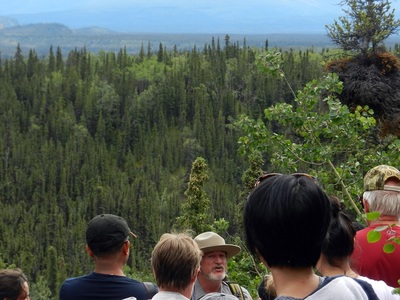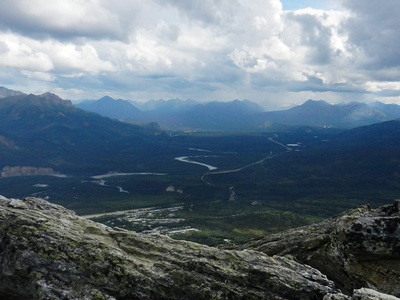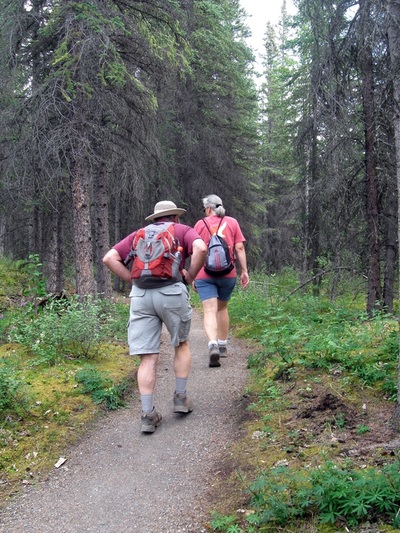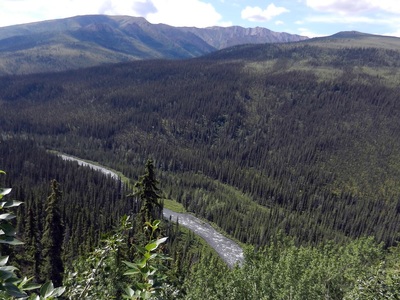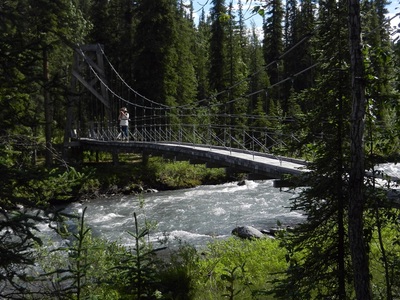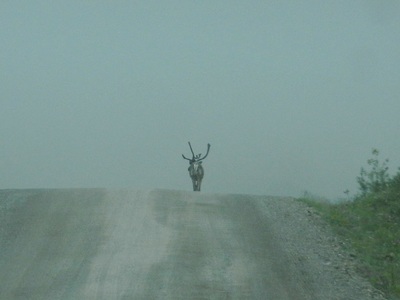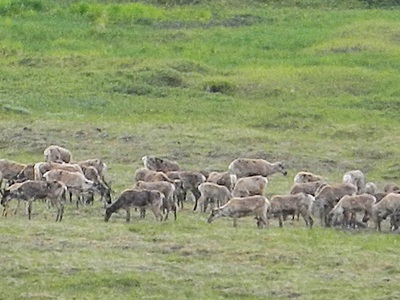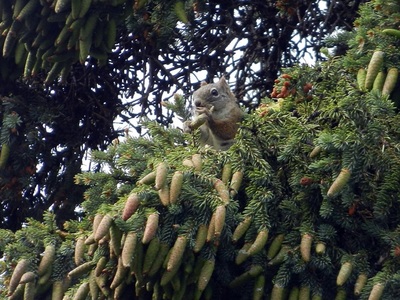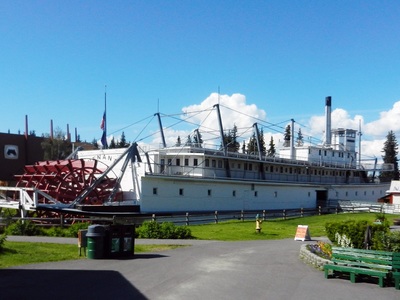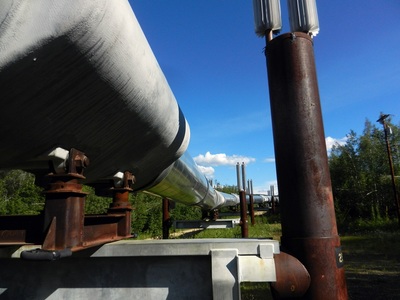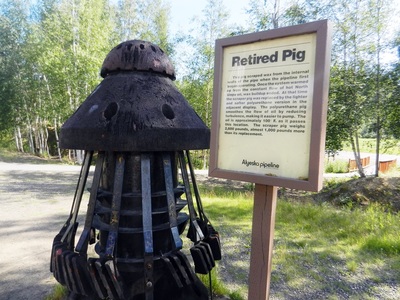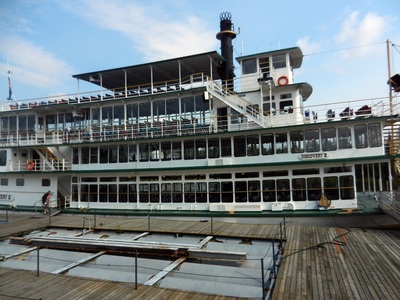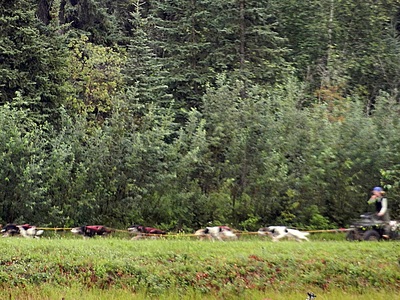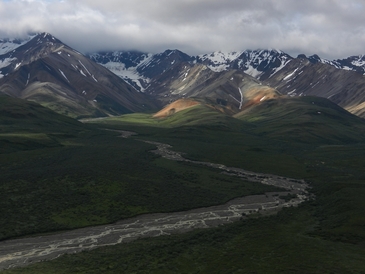 Denali National Park
Denali National Park After a couple of nights at an RV park in the small town of Cantwell south of Denali, we pulled into Denali National Park's Riley Creek campground on the last day of June. Our reservation was for 11 nights, which would give us some downtime, after traveling every few days for two months. We also would have plenty of time to explore this magnificent park. By the end of our stay, we had hiked many trails and learned much about the park, its history, its mission and the wonderful wildlife and ecosystem it protects. We then moved north to Fairbanks, and for the first time this year, experienced summer weather.
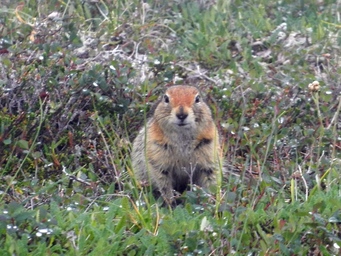 An arctic ground squirrel studies us
An arctic ground squirrel studies us Denali – Both Big and Small
Like many of the national parks in Alaska, Denali National Park is so big that it’s hard to take it all in At 6 million acres, it includes the portion of the Alaska Range that encompasses North America’s highest peak, Denali (which was renamed this year back to its Athabascan name). However, it wasn’t the mountain that caused the park to be created. It was something much smaller – the endangered Dall sheep that live on the steep sides of the mountains in the park. By protecting their ecosystem -- the mountains, the glaciers, the meadows, and glacial rivers -- the wilderness was protected for the caribou, bears, moose, wolves, and many smaller animals that call the park home -- and for the many visitors who visit. But despite the park’s size, the single park road which enters from the northeast side penetrates only 90 miles into the park, and most of it is unpaved and closed to private vehicles. However, it cuts through “animal central”, the primary habitat for most of these animals. Ironically, it is the desire for both the expansive views and the intimacy of animal encounters that draw visitors to the park.
Like many of the national parks in Alaska, Denali National Park is so big that it’s hard to take it all in At 6 million acres, it includes the portion of the Alaska Range that encompasses North America’s highest peak, Denali (which was renamed this year back to its Athabascan name). However, it wasn’t the mountain that caused the park to be created. It was something much smaller – the endangered Dall sheep that live on the steep sides of the mountains in the park. By protecting their ecosystem -- the mountains, the glaciers, the meadows, and glacial rivers -- the wilderness was protected for the caribou, bears, moose, wolves, and many smaller animals that call the park home -- and for the many visitors who visit. But despite the park’s size, the single park road which enters from the northeast side penetrates only 90 miles into the park, and most of it is unpaved and closed to private vehicles. However, it cuts through “animal central”, the primary habitat for most of these animals. Ironically, it is the desire for both the expansive views and the intimacy of animal encounters that draw visitors to the park.
 Quilt at Eielsen Visitor Center depicting the view of Denali that we didn't see that day
Quilt at Eielsen Visitor Center depicting the view of Denali that we didn't see that day Although Mt. Denali is visible from Anchorage and Fairbanks, hundreds of miles away, it requires the right weather. And, like most of these tall mountains, Denali creates its own weather. Some of the best viewpoints are also from points south of the park on the drive north from Anchorage. But as we made our way north, we passed each viewpoint without seeing anything of the mountain. We would learn that only 30% of visitors actually get a chance to see it clearly. We pinned our hopes on seeing it when we went to the Eielsen Visitor Center at mile 66 on the park road. An expensive bus ride, we would only do this once during our stay. Ironically, despite careful planning for weather, the day of our trip to Eielsen found not only the mountain itself, but the visitor center, shrouded in fog so thick you could see barely a tenth of a mile. That didn’t mean we didn’t get to see something special that day, but more about that later.
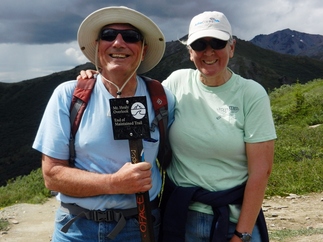 The triumphant hikers
The triumphant hikers One of the things we were looking forward to at the park was getting to hike and bike. There were a number of trails that led out of our campground near the park entrance. We did all of them – exploring Horseshoe lake, historic buildings, glacial streams, suspension foot bridges and the flora and fauna that surrounded them. Our biggest accomplishment was climbing to the Mt. Healy overlook, which rose 1700 ft in 2.5 miles. With that quick a rise, there was little level ground and we could feel it. But we made it to the top to take in some amazing views before the imminent rain clouds caused a much quicker trip down. Our celebratory ice cream cone never tasted so good. Denali’s first 15 miles are accessible by a a free shuttle bus, but we had to limit our hikes to those nearer the entrance. A couple of problem grizzly bears were harassing people near Savage River at the 15 mile mark. So, no hiking was allowed out there. As of this writing, the bears had not been found, but the area was just reopened, having been closed for an unprecedented 3 weeks..
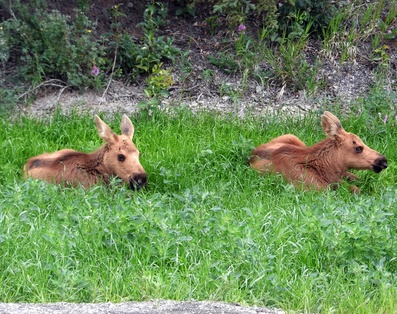 Two orphaned moose calves greeted us as we entered the park
Two orphaned moose calves greeted us as we entered the park It was becoming a bit of a joke. We had been in Alaska for a month, passing by endless signs on the highway to watch out for moose. Despite endless hours of “watching for moose”, the best we were doing was finding what they were leaving behind – moose poop. We’d seen a lot of that. However, that was about to change. As we approached the park our first day, we saw an adult moose cow walking beside the road. As if that wasn’t good enough, when we made the turn into the park, sitting beside the park road were 2 moose calves. We had hoped that we’d see a lot of wildlife in the park, and it appeared we weren’t going to be disappointed.
 Arctic Ground Squirrel crying "wolf"
Arctic Ground Squirrel crying "wolf" The moose encounter was the beginning of a string of close and not-so-close encounters over the length of our stay. We saw beavers busy at their lodges and red squirrels devouring some pine cones they hadn’t stored for the winter. As we made our way further into the park on the paid shuttle, we saw even more – arctic squirrels, ptarmigan, Dall sheep, caribou, and bears. Perhaps our biggest thrill came out of the fog at Eielsen. We had taken a walk along the tundra trail, expecting to only see the flora that was a few feet in front of us, since the view was lost in the mist. Despite the crowds at the visitor center, we were alone as we made our way along the path toward what was a narrow precipice. As we made the turn to head back, a creature emerged out of the fog only a dozen feet ahead of us. It was a wolf heading down the trail we had just left, and certainly unconcerned about us. Wolves are some of the rarest creatures to see in the park, since their numbers are down to less than 50. Our excitement at seeing the wolf was shared, in a different way, by a nearby arctic ground squirrel. This little guy was relentlessly letting his buddies know there was trouble by his persistent cry.
But what was going to happen to those moose calves that had greeted us at the beginning of our trip? Unfortunately, we learned that they were orphans, their mom having been needlessly killed by a park visitor in June. A week into our stay, they had found a new home at the Alaska Wildlife Conservation Center, since it was no longer likely they would survive in the wild. It wasn’t clear what penalty would be paid by the visitor that had killed the mother.
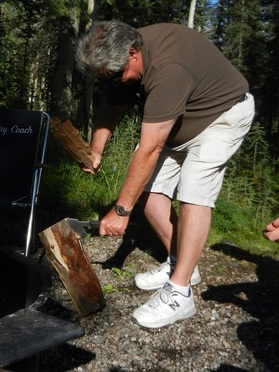 Fred makes some kindling for the campfire with his new birthday present
Fred makes some kindling for the campfire with his new birthday present Back at the campground, we spent many evenings enjoying the outdoors around a campfire with Pat and Fred, trying out some dutch oven peach cobbler or maybe some “pies” made over the fire. Or we might take in a ranger talk in the nearby amphitheater or up at the Science Center. We learned about ravens, migratory birds, the lynx, geologic formations in the park, just to name a few subjects. Because of the potential dangers of our interactions with the bigger wildlife, each presentation began with the "BMW" talk – about safety around Bears, Moose and Wolves. By the end of our stay, we could easily have given the talk ourselves.
 Susitna Glacier descends along the Denali Highway
Susitna Glacier descends along the Denali Highway One day, we took a road trip down the unpaved Denali Highway that runs east off the Parks Highway south of the Alaska Range toward the Richardson Highway across the center of the state. It provides views of the Nenana and Susitna Rivers, along with the Alaska Range and some of the glaciers that feed the rivers. Ironically, it was from this highway that we actually got our best view of the Mt. Denali, putting us in the ranks of the 30%. We drove for about 70 of its 135 miles to the Alpine Creek Lodge, arriving in the pouring rain, but found a warm welcome inside. We settled in for lunch and got to meet the owners and staff of this remote Alaskan roadhouse, learning more about how their life changes in winter. They groom a trail along the road for the 70 miles we had just traveled, enabling travelers by snowmachine or dog sled to reach them. The winter actually makes travel easier.
As the rain cleared, we got a glimpse of the lodge’s commanding view of the surrounding landscape. Then it was time to head back.
As the rain cleared, we got a glimpse of the lodge’s commanding view of the surrounding landscape. Then it was time to head back.
 The Alaska RR continues to stop at Denali NP daily in summer.
The Alaska RR continues to stop at Denali NP daily in summer. By the end of our stay at Denali National Park, we had come to understand the park much better and to appreciate those who had fought to preserve its wilderness and the animals within. By protecting some unique animals, much more had been preserved for those of us visiting nearly 100 years after its founding.
 Tanana Valley RR Museum at Pioneer Park in Fairbanks
Tanana Valley RR Museum at Pioneer Park in Fairbanks Fairbanks – Summer at Last
While the lower 48 bakes in record summer heat, we have been spending most of our time in jeans and sweatshirts. You’ll get no complaints from us, but as we prepared to move north to Fairbanks, we were taken aback by the forecast. High’s in the upper 80’s. Is that a typo? It’s like jumping from early spring to late summer in the space of a day. As we dug out our shorts and T-shirts, we were reminded that Fairbanks unique geography makes it home to the hottest temperatures in Alaska. The Alaska Range to the south and the Brooks Range to the north block its access to moderating ocean temperatures.
While the lower 48 bakes in record summer heat, we have been spending most of our time in jeans and sweatshirts. You’ll get no complaints from us, but as we prepared to move north to Fairbanks, we were taken aback by the forecast. High’s in the upper 80’s. Is that a typo? It’s like jumping from early spring to late summer in the space of a day. As we dug out our shorts and T-shirts, we were reminded that Fairbanks unique geography makes it home to the hottest temperatures in Alaska. The Alaska Range to the south and the Brooks Range to the north block its access to moderating ocean temperatures.
 Check out the sign in the lower left corner
Check out the sign in the lower left corner We planned a somewhat longer visit than most visitors plan for Fairbanks, since we wanted to stay long enough for the World Eskimo-Indian Olympics. And we found an inexpensive campground with power at the Tanana Valley Fairground RV Park to be our home for the stay. Once settled in, we began exploring with the usual first stop – the Visitor Center. Here we took part in a ranger talk, since the National Park has staff here to guide people into the many remote National Parks in northern Alaska. We picked up info about the Olympics and possible trips north. After one more (and perhaps our last) movie about the Northern Lights, we toured the well-done displays about interior Alaska through the four seasons. Then it was time for lunch at the “Northernmost Southern BBQ”, Big Daddy’s. A great start to our visit.
 Tanana Valley RR Engine #1
Tanana Valley RR Engine #1 We moved on to Pioneer Park in the afternoon, which has a mix of historic structures, kids activities, a small historic RR and an air museum. We learned more about the small Tanana Valley RR which predated the Alaska RR from Anchorage, and the Nenana sternwheeler one of many freight boats that formed the lifeline that connected Fairbanks with the small villages north and west of here. The freight runs, especially the sternwheeler’s route along the Tenana and Yukon Rivers provided these remote populations supplies not available any other way. There could be as many as 6 barges being pushed ahead of the ship. From Pioneer Park, we headed north on the Steese Highway to the Alyeska Oil Pipeline viewing site. While we had seen the terminus in Valdez, the origin in Prudhoe Bay was still several hundred miles and one mountain range north of Fairbanks. It sits above ground here and for almost half of its length because of the permafrost. To bury the warm pipe in permafrost would create an instability that would damage the pipe. To prevent any inadvertent heating of the permafrost, heat “fins” are positioned on the support posts periodically to diffuse any heat built up below ground.
 Tour of the UAF Geophysical Institute
Tour of the UAF Geophysical Institute The next day, we went back to school. Fairbanks is home to the University of Alaska Fairbanks, which is just down the road from our campground. They offer free tours of the campus and some of the individual schools, which have some unique areas of study. From earthquakes and volcanoes to arctic climate, we could learn about a number of topics from the perspective of this northernmost state. We chose to visit the Geophysical Institute to learn more about its study of earthquakes and volcanoes, satellite imagery and unmanned aircraft research. Apparently Alaska has earthquakes all the time. We actually were driving through one as we left Denali, although none of us felt it. The UAF seismologist explained the different faults running through Alaska and tectonic forces acting there. There were banks of monitors keeping track of numerous remote stations that sense the earth’s movement in Alaska and report back to the university. The data is studied and used to put out warnings when one of these earthquakes is more severe. On a completely different topic, we learned about their UAV research. These are used to study sea lions and inspect the pipeline, as some examples. We got to try to pilot one using a simulator, some of us more successful than others at avoiding crashes.
 Cathy in the Alaska Outhouse experience in the Museum of the North
Cathy in the Alaska Outhouse experience in the Museum of the North Another afternoon, we toured the Museum of the North on campus with displays of Alaskan art and history, along with movies about the arctic dinosaur fossils and the bowhead whale.
 Jessie Royer with some Alaskan husky puppies
Jessie Royer with some Alaskan husky puppies One of the must-do excursions in Fairbanks is the Riverboat Discovery, which takes us to a re-creation of an Inupiaq village, with Alaska native interpreters. It was made even more interesting when we saw Jessie Royer again, this time explaining mushing to a boatload of us and answering questions about her dogs and the Iditarod. Despite the warm temperatures, we had to take time to experience Fairbanks in the winter. We stepped into the “Alaska at 40 below” room for a photo op. When we flubbed the first picture, we had to return a second time. We made sure we didn’t have to do it a third time.
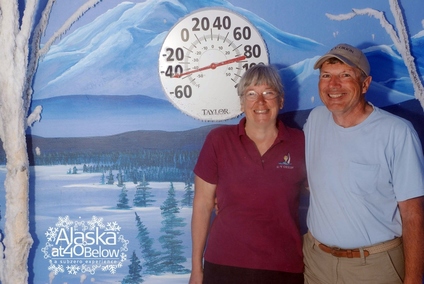 Do we look cold?
Do we look cold? By the end of our first week in Fairbanks, the temperatures in the high 80’s had been replaced by the low 60’s. It seemed like summer was over just as fast as it had begun.
 Dave happy to be talking to someone on the CB with our new antenna
Dave happy to be talking to someone on the CB with our new antenna RV Stuff
Can you hear me now? We had spent months on the road with Pat and Fred, and a frequent complaint was we couldn’t talk to each other underway. Although both of us had CB’s, both units were old and hadn’t been checked out before getting underway. It turned out we had no range at all, so they were pretty ineffective. Once in Fairbanks, we found someone with the knowledge and testing equipment to help us understand the problems with our units. It turned out both of us needed new antennas. We purchased and installed a new 4 foot antenna which greatly improved our transmit and receive capability. Fred’s antenna was more integrated into his coach and more difficult to replace. After a couple of parts runs and different approaches, he successfully installed the antenna. We were able to talk to each other further away, but the real test will be when we head out on the road again.
Can you hear me now? We had spent months on the road with Pat and Fred, and a frequent complaint was we couldn’t talk to each other underway. Although both of us had CB’s, both units were old and hadn’t been checked out before getting underway. It turned out we had no range at all, so they were pretty ineffective. Once in Fairbanks, we found someone with the knowledge and testing equipment to help us understand the problems with our units. It turned out both of us needed new antennas. We purchased and installed a new 4 foot antenna which greatly improved our transmit and receive capability. Fred’s antenna was more integrated into his coach and more difficult to replace. After a couple of parts runs and different approaches, he successfully installed the antenna. We were able to talk to each other further away, but the real test will be when we head out on the road again.
 New outlet installed
New outlet installed We were pleased with the our new batteries’ performance over the long stretch off the grid at Denali. Dave took time while we were there to install a new AC outlet that was powered by the generator directly. Since we prefer to use the new battery charger we installed, instead of plugging in the 30-A cord to the generator, the AC outlets don’t work when the generator is running. Now, we have one that does, without having to run a cord out the window to the generator.

